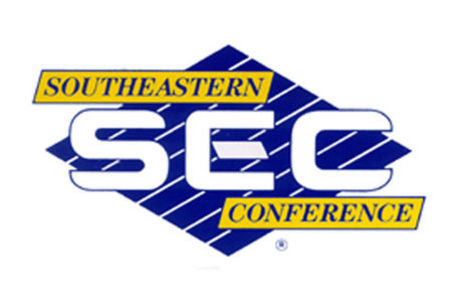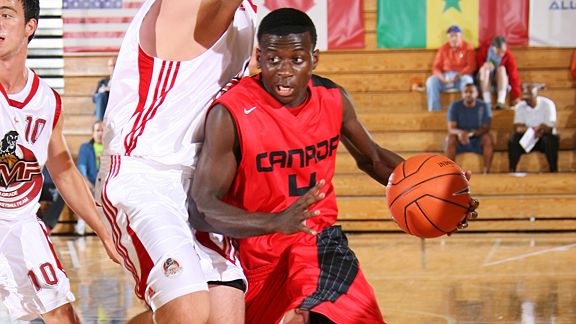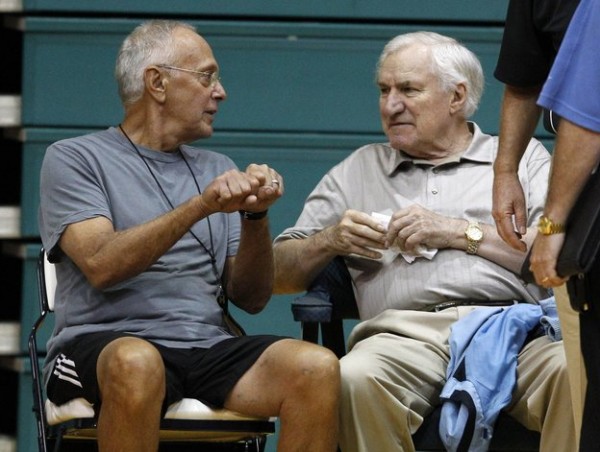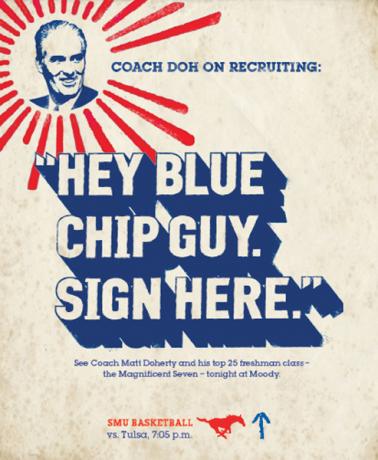Who’s Got Next? Reviewing the Jordan Brand Classic
Posted by rtmsf on April 18th, 2011Introduction
Throughout the past week, there have been many great performances and match-ups at high school events such as Austin Rivers (#1 – Duke) and Bradley Beal (#6 – Florida) at the Jordan Brand Classic; there have been numerous developing stories such as where Oklahoma is on Perry Ellis’ (#20) list and what Greg Whittington’s (Georgetown) impact on Otto Porter’s (Georgetown) commitment to Georgetown will be; there’s been a key commitment which will make a big impact on the ACC; the New York Times did an interesting article linking Facebook and recruiting; a West Virginia commit joined the likes of LeBron James, Carmelo Anthony and Dwight Howard; and much more.

Austin Rivers (#1 – Duke) and Bradley Beal (#6 – Florida) fought for the #1 spot at shooting guard in the Jordan Brand Classic. (Credit: ESPN)
What We Learned
The Best SG in the Class of 2011. Going into the Jordan Brand Classic on Saturday night you knew that the battle between Rivers and Beal would be the primary match-up to watch. Both of these guys are great scorers and can hit shots from anywhere on the floor. They also have excellent three-point range and finish well above the rim. In this game, Rivers got the best of Beal as he finished with 16 points, six rebounds and four steals (the steals being very impessive due to the lack of defense in all-star games) whereas Beal had 15 points and eight rebounds. Neither player shot the ball very well, combining for 11-32 shooting from the field and 1-8 shooting from the three-point line. However, the bad three-point percentage is in large part due to both guys taking very long threes that they wouldn’t normally take in a serious game. Look for these two guys to be two of the best scorers in college basketball starting next season.
Perry Ellis Likely Not Oklahoma-Bound. From what Fonda Ellis, Perry Ellis’ mom, told me (see full quotes from her in the “What They’re Saying” Section, below), it seems as though Oklahoma is losing ground in the Ellis sweepstakes (#20). This loss of interest looks to primarily be a result of the Sooners’ coaching change from Jeff Capel to former UNLV head coach Lon Kruger. Although Kruger said in a phone call to Ellis last week that he was still the Sooners’ top priority and that he wanted him to take an official visit to the OU campus, Ellis will have to get used to an entirely new coaching staff there. Ellis is also considering Kansas, Kansas State, Kentucky, Memphis and Wichita State and told me in an interview last month that he’s looking to “be comfortable, have a good relationship with the coach and be in a system I like.”
Greg Whittington and Otto Porter’s Commitments. According to what Greg Whittington (Georgetown) told me Sunday after The Capital Classic, he is the one who got Otto Porter (#40 – Georgetown) to become a Hoya this past week (see full quotes from Whittington in the “What They’re Saying” Section, below). Whittington was able to convince Porter to commit to Georgetown due to the conference they’ll be in, among many other things. However, one thing that seemed to really help the Hoyas was the coaching change at Missouri since the Tigers were believed to have been the frontrunners. According to an ESPN source, the new staff at Missouri did not even have a chance to meet with Porter and his family before Porter made his decision to attend GU. Porter was a big-time pickup for the Hoyas since he is very long and has one of the best mid-range games in his class. He is a match-up problem for almost everyone he faces due to his height and he rebounds the ball and runs the floor well too. He is also good on the defensive end on the floor and is a solid ball-handler. Porter needs to improve on his strength more than anything else but his all-around game is solid and he should make a positive impact at Georgetown next year.
What You Missed

Anthony Davis (#4 – Kentucky) and James McAdoo (#7 – North Carolina) were the Co-MVPs at the Jordan Brand Classic.
Power Forwards Dominated Jordan Brand Classic. Anthony Davis (#4 – Kentucky) and James McAdoo (#7 – North Carolina) were the co-MVPs in the 10th annual Jordan Brand Classic Saturday with Davis recording 29 points (second highest in event history to LeBron James’ 34 points) on 13-15 shooting from the field and 11 rebounds, and McAdoo tallying 26 points on 10-16 shooting from the field and 14 rebounds. Davis also added four blocks and McAdoo hit the game-clinching free throws with 1.6 seconds left which gave the East a 113-109 victory over the West. Both players ran the floor well and were able to knock down the perimeter shot. Although Davis had the better overall game, McAdoo was more impressive since he showed the ability to not only score in the paint, but he also made several nice mid-range jumpers and multiple three-pointers which showed off his range. Both showed good court vision and passing skills as well as an ability to make the pass in transition or out of the low post when double-teamed. Kyle Wiltjer (#26 – Kentucky) also brought back his sky hook from the McDonald’s game to this event and Johnny O’Bryant (#28 – LSU) consistently knocked down a turn-around jumper that will be deadly if he adds other moves to his arsenal.


















































